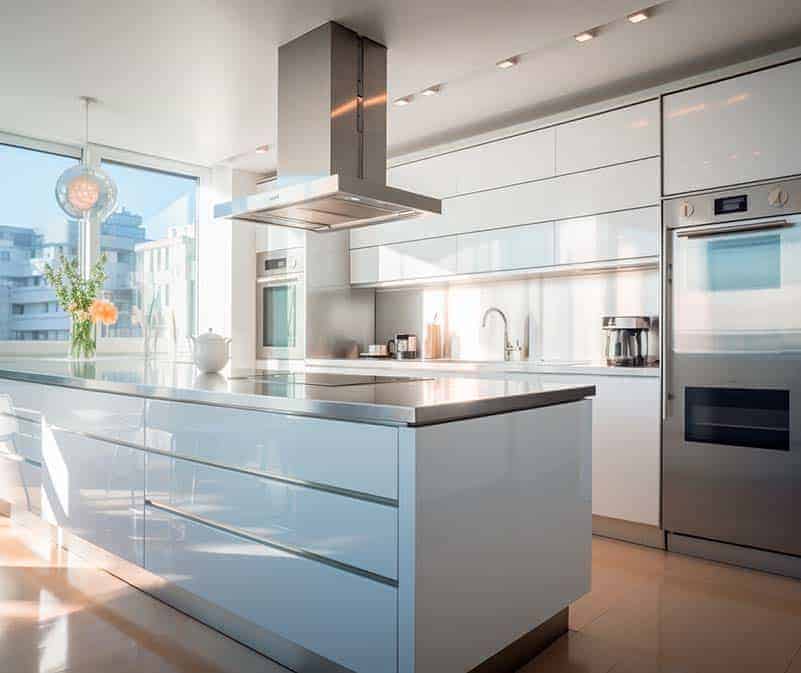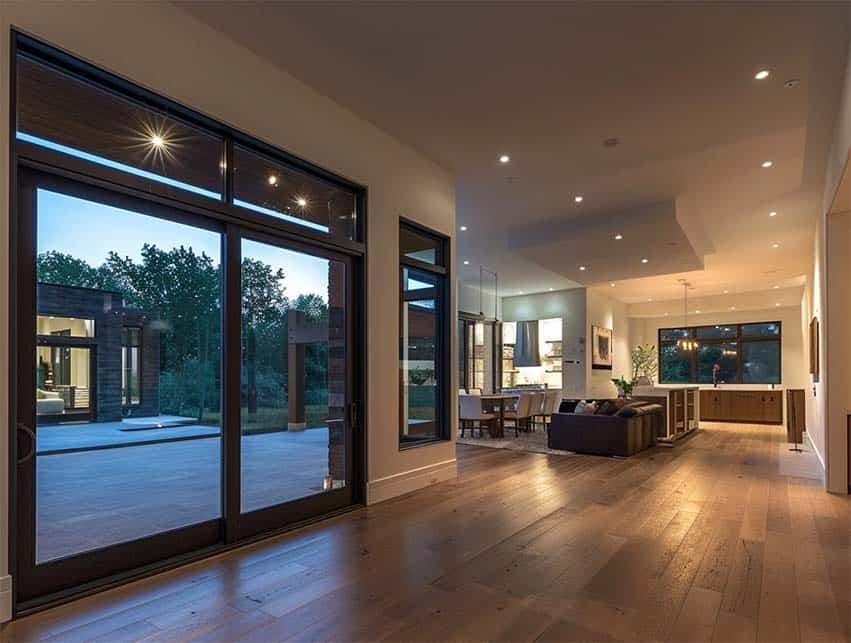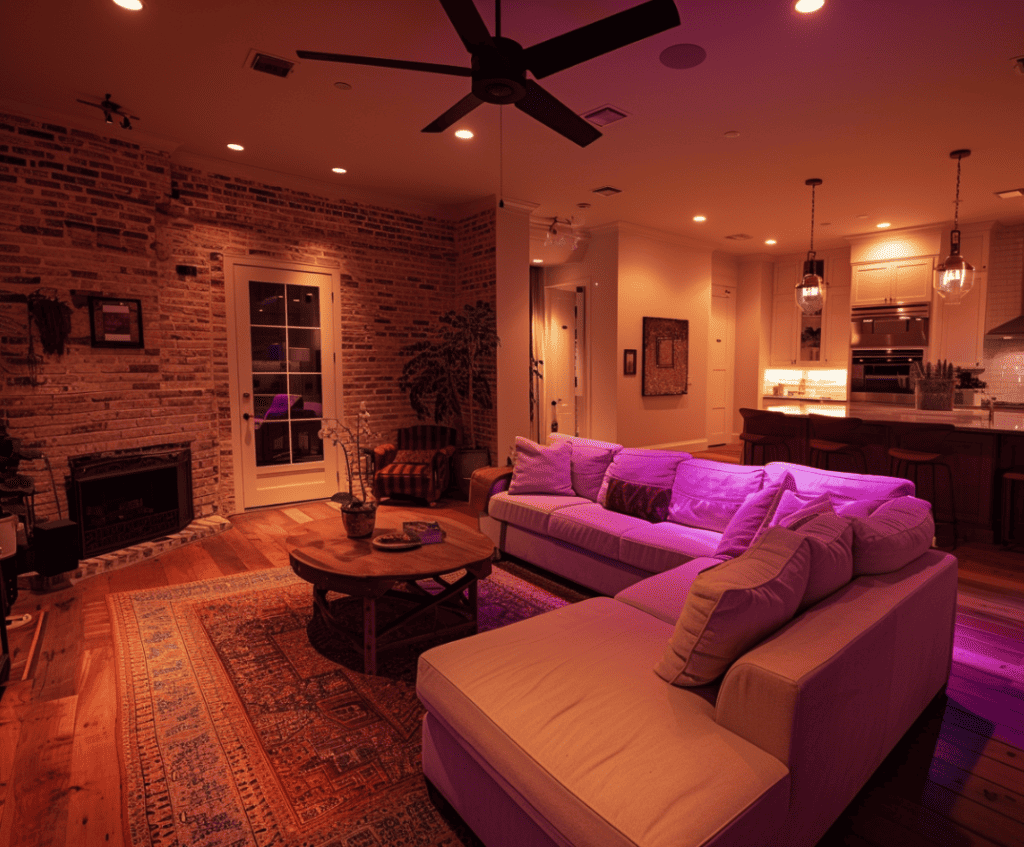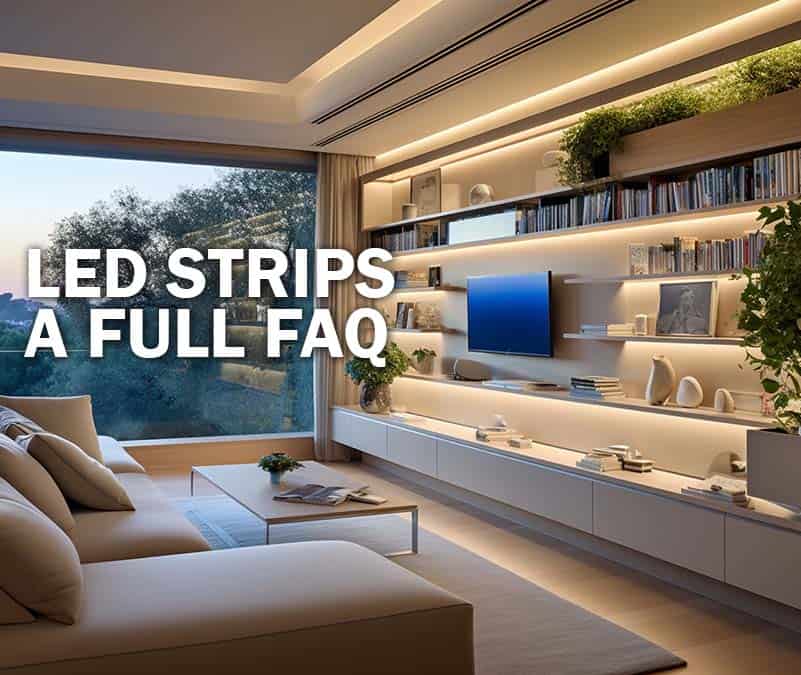From Fluorescent Bulbs to LEDs: A Good Idea?

Is it time to switch out of fluorescent tubes and bulbs?
In the course of our work as residential electricians in San Antonio, homeowners often ask us if there are any actual advantages switching from fluorescent bulbs or tubes to LED lights, considering the price of LEDs. People want to change, but beyond the obvious aesthetic reasons, they are not certain this is the right move for their home.
Over the years, we have done a lot of research on the topic, and compared many fluorescent products with LED products designed to be used in homes. We tried in this article to present some facts and figures to help you in your thought process.
LEDs vs. fluorescents: a bit of history
LED technology became available in DIY stores like Lowe’s and Ace Hardware only about 10 years ago. By comparison, neon lights started to be used in the U.S. in the first half of the 20th century. One technology is still relatively new, the other had a long, proven history.
Did you know for instance that the very first fluorescent tube was launched by General Electric in America in 1938? Before this, factories and workshops used incandescent bulbs.
Both commercial and industrial companies took to neon technology due to its energy efficiency and the longer lifespan of products. Neon tubes could also be blown by glass masters into different shapes for signage and exterior lighting. This made them very popular with retail stores.
American households on the other hand had to waite till the end of the 50s and the early 60s to adopt fluorescent lighting on a wide scale. Prices became more affordable, and manufacturers came up with more pleasing models.
Repeating history?
Home ownership also contributed to this trend, as it gradually rose in the 60s and throughout the early 80s. In the prosperous period of post-WWII economy, middle class America invested more money in decorating their own interiors.
Likewise, the oil shocks of 1973 and 1979 and the inflationary periods that followed sustained the adoption of fluorescents as households needed more economical lighting than incandescent bulbs.
We are observing today a similar set of factors behind the embracing of LED technology by households in our region of San Antonio. People switch from whatever they have to LED lighting for several reasons:
- Greater affordability: LED are becoming less expensive
- Greater availability: we can find LEDs everywhere, and it’s easy to replace a light
- Improvements in design: LED fixtures are just more beautiful than other bulbs
- Better energy efficiency than other lights, bulbs, and tubes
- Longer lifespan: people don’t have to buy light bulbs as often
- Increase in time-at-home: we spend so much more time in our homes today than before the pandemic, that we get bored faster by the look of our interior. We need to change more often.
Yet, fluorescent bulbs are relatively inexpensive to purchase, and very economical to operate. So, why switch to LED then?
LED vs. fluorescents: benefits
There are a number of well-documented facts that support the adoption of LED over fluorescent tubes and bulbs. As residential electricians in San Antonio, we would say the most critical for homeowners are as follows:
Longer lifespan
The average lifespan of a fluorescent bulb is about 7,000-15,000 hours. LEDs can last 25,000 to 50,000 hours. On average, LEDs can last 2-3 times longer than fluorescents. Considering that 25% of U.S. homes use 40+ light bulbs at any given time, replacing light fixtures is not an insignificant yearly expense. the frequency of replacement is also an inconvenience.
Energy efficiency
LEDs typically consume 25%-30% less energy than fluorescent lights. Traditional fluorescent lamps typically have an efficiency of 60-70 lumens per watt, while LEDs can achieve efficiencies of 80-100 lumens per watt. On top of that, a fluorescent bulb (or tube) will emit less and less light as it ages. On the contrary, a LED light will remain as efficient throughout its lifespan as it was on Day 1.
Power consumption
LEDs typically consume less power (watts) than fluorescent lights for the same light output (lumens). For instance, a 10W LED light can produce the same amount of light as a 13-15W fluorescent bulb. Both are less power-hungry than incandescent bulbs, for sure!
Decreased heat
In another article on LED lighting benefits, we mention the huge energy efficiency differential (800%) between an incandescent bulb and a LED light, as shown by the research published by the Center for Nanoscale Science at U-Penn. LEDs convert more electricity into light.
Of the 5 most common lighting devices, incandescent bulbs are the least energy-efficient, followed by halogen lamps, neon tubes, fluorescent tubes, and LED lights. LED lights also generate the less heat of the 5 devices, followed in ascending order by fluorescent tubes, neon tubes, incandescent bulbs, and halogen lamps. Halogen light produce the highest heat signature of the 5 devices.
Fluorescent tubes are not very hot to the touch but their ballast are. The ballast is subject to several heat-generating factors and require adequate ventilation to avoid creating a fire hazard.
LEDs do offer a clear advantage when an electrician or a contractor builds a lighting system in small spaces as they need the void space around them for heat dissipation. In homes and offices, the low heat signature of LEDs also decreases the need for air conditioning, generating additional power savings.
Improved light quality
LED technology provides a more consistent light output, with less flickering and no noticeable warm-up time. LEDs also cover a broader spectrum of color temperatures. As we mentioned earlier, this is a big factor behind the fact homeowners love LED technology.
Beyond the different types of whites that both LED and fluo bulbs offer (from warm white to cool daylight), LEDs come in many different colors. Some LED lights even offering thousands of hues that can be varied with a phone or a small remote control. We all love to “change the mood” of a room, and LEDs give us the capability to do this. Fluorescent bulbs? Not so much.
Now, from what we observed as residential electricians, a lot of people like to “mix and match”. They typically don’t go “all LED”. They prefer some incandescent bulbs here, some fluo bulbs there, and some LED lights there.
People also have light fixtures they don’t want to replace. This is often the case, for instance, of fluorescent tube fixtures installed on kitchen ceilings (because of their efficiency in lighting up the area).
Can you actually replace a fluorescent tube with a LED tube? Yes, here is how.
Types of LED tubes
There are different types of LED tubes available on the market, and we first need to discuss them:
Type A & Type B tubes
These tubes are versatile. They can work with both “single-ended” and “double-ended” connections. They are also designed to be compatible with a variety of fixtures.
Ballast-bypass tubes
These products are engineered to run directly on line voltage, bypassing the need for ballasts. They work great for fixtures with a faulty ballast, or when the goal is to maximize energy savings. (Ballasts consume part of the electricity that goes to the fluorescent tubes).
Ballast-driven LED tubes
These tubes are designed to work with the ballast of an existing fixture. They are a simple drop-in replacement solution, with no rewiring required. They still rely on the ballast however, and this means additional energy usage. Also, eventually, the ballast will die and requirement replacement.
Converting from fluorescent tubes to LED tubes
We will cover here the steps we take to convert a fluorescent fixture into a LED fixture. The process varies slightly depending on the type of LED replacement tubes chosen by our clients.
For ballast-bypass tubes
a. Safety first
We always start by turning off the power at the circuit breaker. Working with live wires is dangerous, so we ensure there is no current flowing to the fixture.
b. Accessing the fixture
We remove the fluorescent tubes and set them aside. We access the ballast by removing the ballast cover or reflector.
c. Bypassing the ballast
We disconnect the wires from the ballast and connect the wires directly to the mains power. Depending on the design of the LED tube, one end may connect to the neutral wire, and the other end may connect to the hot wire.
d. Installing the LED tubes
Once we have rewired the fixture, we install the LED tubes. We make sure the correct end (if specified) is connected to the power.
e. Testing the lights
We turn on the power to test the lights. AS we do everything by the book, the LED tubes light up immediately.
Important note: There may be additional steps to take, depending on the installation. We describe the steps we take most generally. This is NOT a DIY guide. If you want to do this yourself, please do a bit of additional research and watch some videos. As licensed electricians, we always tell clients that working with electricity is dangerous and that certain things are best left to professionals. We publish these procedures only for informational purposes.
For ballast-driven LED tubes
a. Simple replacement
For these bulbs, the process is straightforward. We simply remove the old fluorescent tube and replace it with the LED tube designed for ballast operation. If you buy the LED tube yourself, you need to make sure the ballast of your light fixture is compatible with the LED tube.
Important note: This procedure is simple; beyond the matter of selecting the appropriate LED tube for your ballast, you can easily do this yourself. BUT YOU MUST take precautions before going up a ladder or stepping on a stool. This is something we actually never recommend to our older clients: the risk is too great for them to expose themselves to a fall with the medical problems that ensue.
Safety Precautions and Best Practices
Talking about safety, here are a few things you MUST absolutely do when you are preparing to work on electrical devices, like converting a light fixture. This is not an exhaustive list, ok? Please do your research to achieve full safety.
1. Turn off the power
Before starting any work, always turn off the power at the circuit breaker. This will ensure that there is no risk of electric shock.
2. Use the right tools
Having the right tools for the job will make the process smoother and safer. You will need wire strippers, screwdrivers, and wire nuts for most conversions.
3. Check all connections
Before restoring power, double-check all wire connections to ensure they are secure. Loose wires lead to shorts, sparks, and other electrical hazards that can cost your home, even your life. If you are not sure of what you are about to do, just don’t do it and call a professional licensed electrician.
4. Dispose of old components properly
When disposing of old fluorescent tubes and ballasts, you need to ensure you follow the San Antonio city code. Fluorescent tubes typically contain mercury, a toxic poison. Some components need to be disposed of in a specific manner.
5. Have a second person close by or watching you
Whenever you work with electricity or up a ladder, or standing on a stool, you need to have a second peson watching you or close by, and ready to help you in case something happen.
Switching out of fluorescent? Yes!
As professional licensed electricians with almost 30 years of experience doing all types of electrical installations in homes and businesses in San Antonio, it makes definite sense to switch from fluorescent tubes and bulbs to LED lighting.
This is a good decision for both the environment, the enjoyment of your home, and your wallet. Not only LED provides better lighting than neon tubes, but in the long run, it is also less expensive to purchase and to operate.
We have seen really good progress in LED technology these last few years. The quality of the light emitted has become better. LEDs offer us the possibility to relook our homes entirely without having to invest much money. And with the rising cost of electricity, LEDs save us very significant money.
Fluorescent fixtures are, by far, not as power-hungry as incandescent bulbs. But they still consume more energy than LEDs, cost more to purchase for the same light output, and require replacement more often.
So, what’s not to like about LED lighting?
How can All Star Electric help you?
As mentioned earlier, All Star Electric is a team of licensed residential electricians working on all types of electrical projects in San Antonio and its greater area. We have been in business for almost 30 years. That means we have seen all types of technology, all kinds of products, and definitely many, many problems to be fixed in existing electrical installations.
We do electrical inspections which ensure your own home or business is safe. From faulty installations to dangerous incidents, there is often not much difference: it’s only a matter of time and circumstances. Don’t expose yourself and your family to unnecessary and potentially devastating risks.
We also install Level 1 and Level 2 EV chargers. This is one of our specialties, and we are very proud to be a Tesla certified installer. If you have an EV, why not talk with us about the pros and cons of installing a charging station in your home?
Whatever your electrical installation requires, we can do it. Converting your home to a smart LED lighting system from incandescent bulbs or fluorescent tubes is something we do routinely. If you have a project in mind, just call us at (210) 391-0274. We offer reasonable rates, and very high quality workmanship as attested by our A+ rating with the BBB (we have maintained our A+ with 0 complaints since 2009).
Additional resources
We researched thoroughly the facts and figures presented in this article. Things can change as new technology develops, so the figures can change. But we firmly believe they are currently accurate.
Here is a link to a full FAQ we wrote about LED lighting
Here are some links to documents published by the Department of Energy.
- New Energy Efficiency Standards for Lightbulbs – Department of Energy
- Purchasing Energy-Efficient Light Bulbs | Department of Energy
- Purchasing Energy-Efficient General Service Fluorescent Lamps
- Lighting Choices to Save You Money | Department of Energy
FAQ
Switching to LED lighting offers several benefits, including longer lifespan, better energy efficiency, and improved light quality. LEDs can last 25,000 to 50,000 hours, 2-3 times longer than fluorescent bulbs, and consume 25%-30% less energy.
LEDs typically achieve efficiencies of 80-100 lumens per watt, while traditional fluorescent lamps have an efficiency of 60-70 lumens per watt. LEDs maintain their efficiency throughout their lifespan, unlike fluorescents, which degrade over time.
Yes, it is true. This is what make LED lights better suited for tight spaces: they require less heat dissipation. (The smaller form factor also plays a role in tight corners). If you are concerned with energy savings, the low heat signature of LEDs also reduces your need for air conditioning compared with fluorescent lighting fixtures.
In general, yes, it’s not very complicated as long as you know what you are doing. Of the two major types of LED tubes, one is directly compatible with existing ballasts. They are plug and play. The other is designed to run directly on line voltage (your mains). These bypass the need for ballasts.
First of all, let’s just state that if you don’t know what you’re doing, don’t DIY it. Just call a licensed electrician and they will do it for you without risking a fire or a short circuit. If you feel confident enough to DIY the job, start by turning off the power at the circuit breaker. That will take care of the risk of electrocution. Then, use tools with insulated handles, designed to protect you from electrical shocks. Last, and we can’t insist enough on this one, double-check your wire connections.



























